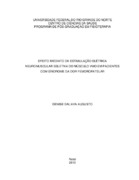Please use this identifier to cite or link to this item:
https://repositorio.ufrn.br/handle/123456789/16682| Title: | Efeito imediato da estimulação elétrica neuromuscular seletiva do músculo VMO em pacientes com síndrome da dor femoropatelar |
| Authors: | Augusto, Denise Dal'ava |
| Advisor: | Brasileiro, Jamilson Simões |
| Keywords: | Eletromiografia;Estimulação elétrica neuromuscular;Reabilitação;Vasto medial oblíquo;Electromyography;Neuromuscular electrical stimulation;Rehabilitation;Vastus Medialis Oblique |
| Issue Date: | 13-Apr-2010 |
| Publisher: | Universidade Federal do Rio Grande do Norte |
| Citation: | AUGUSTO, Denise Dal'ava. Efeito imediato da estimulação elétrica neuromuscular seletiva do músculo VMO em pacientes com síndrome da dor femoropatelar. 2010. 86 f. Dissertação (Mestrado em Movimento e Saúde) - Universidade Federal do Rio Grande do Norte, Natal, 2010. |
| Portuguese Abstract: | A Síndrome da Dor Femoropatelar (SDFP) é freqüentemente associada à disfunção do Vasto Medial Oblíquo (VMO). Diversos estudos têm demonstrado a impossibilidade de ativar seletivamente este músculo por meio de exercícios. Avaliar os efeitos de uma única sessão de Estimulação Elétrica Neuromuscular (EENM) seletiva do músculo VMO, em sujeitos com SDFP. Foram avaliadas 38 mulheres sendo 20 pertencentes ao grupo controle (24,15 ± 2,60 anos) e 18 com diagnóstico de SDFP (25,56 ± 3,55 anos). Ambos avaliados antes e após um protocolo de eletroestimulação. Para medida de comparação dos grupos antes e depois do tratamento, foram avaliados, o desempenho isocinético, a intensidade de ativação muscular (Root Mean Square RMS) e o início da ativação (onset) do VMO comparado ao vasto lateral (VL). Para análise estatística foi utilizado o programa SPSS 15.0, com um nível de significância de 5%. Resultados: Nossos dados mostraram um aumento na intensidade de ativação (RMS) do músculo VMO após a EENM, em ambos os grupos de estudo. Durante a contração concêntrica o RMS do VMO antes da EENM foi 105,69 ± 32,26 μV e depois de uma única intervenção foi de 122,10 ± 39,62 μV (p=0,048) para o grupo controle. No grupo com SDFP, encontramos um comportamento semelhante, com RMS do VMO antes da EENM de 96,25 ± 18,83 μV e 139,80 ± 65,88 μV depois da intervenção (p=0,0001). Entretanto, não foi evidenciada alteração no valor RMS do músculo VL. O onset foi calculado através da subtração do onset do VL pelo onset do VMO. Para o grupo com SDFP, o onset antes da intervenção foi de -0,007 ± 0,14 ms, evidenciando um atraso do VMO em relação ao VL, e após a EENM foi 0,074 ± 0,09 ms (p=0,016), mostrando uma ativação do VMO anterior ao VL. O mesmo ocorreu para o grupo controle. Observamos também que a EENM aumentou a potência extensora do joelho, durante a contração concêntrica em ambos os grupos. Antes da intervenção a média da potência era de 28,97 ± 9,01 W para o grupo SDFP e depois da EENM foi de 34,38 ± 7,61 W (p=0,0001). Conclusão: Observou-se um aumento na atividade eletromiográfica do VMO após a eletroestimulação, além de um efeito antecipatório deste músculo |
| Abstract: | Patellofemoral pain syndrome (PFPS) is described as anterior or retropatellar pain knee in the absence of other pathologies and is frequently associated with dysfunction of the vastus medialis oblique (VMO). However, several studies have demonstrated the inability to selectively activate this muscle through exercise. To evaluate the effect of Neuromuscular Electrical Stimulation (NMES) selective VMO in women with syndrome. We evaluated thirty-eight women: twenty in the control group (24.15 ± 2.60 years) and eighteen diagnosed with PFPS (25.56 ± 3.55 years). Both groups were evaluated before and after a protocol of electro stimulation. To measure for comparing groups before and after treatment, we assessed the extensor torque concentric and eccentric knee through an isokinetic dynamometer, the intensity (Root Mean Square - RMS) and the onset of activation (onset) of VMO compared to the vastus lateralis (VL) in two types of exercise: open and closed kinetic chain. . Statistical analysis was performed using SPSS 15.0, with a significance level of 5%. Results: Our data showed an increase in the intensity of activation (RMS) of the VMO muscle after NMES in both study groups. During concentric contraction the RMS of the VMO before the NMES was 105.69 ± 32.26 μV and after a single intervention was 122.10 ± 39.62 μV (p = 0.048) for the control group. In the group with PPS, we found a similar behavior, with RMS of the VMO before NMES of 96.25 ± 18.83 μV and 139.80 ± 65.88 μV after the intervention (p = 0.0001). However, there was no evidence in the RMS value of VL muscle. The onset was calculated by subtracting the onset of VL by the onset of VMO. For the group with PFPS, the onset before the intervention was -0.007 ± 0.14 ms, indicating a delay of the VMO relative to VL, and after NMES was 0.074 ± 0.09 ms (p = 0.016), showing an activation previous VMO to VL. The same occurred for the control group. We also observed that NMES increased knee extensor power during the concentric contraction in both groups. Before the intervention the mean power was 28.97 ± 9.01 W for the PPS group and after NMES was 34.38 ± 7.61 W (p = 0.0001). Conclusion: We observed an increase in electromyographic activity of the VMO and also an anticipatory effect of this muscle |
| URI: | https://repositorio.ufrn.br/jspui/handle/123456789/16682 |
| Appears in Collections: | PPGFS - Mestrado em Fisioterapia |
Files in This Item:
| File | Description | Size | Format | |
|---|---|---|---|---|
| DeniseDA_DISSERT.pdf | 644,13 kB | Adobe PDF |  View/Open |
Items in DSpace are protected by copyright, with all rights reserved, unless otherwise indicated.

